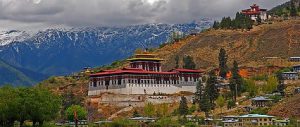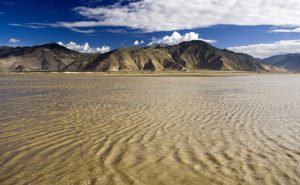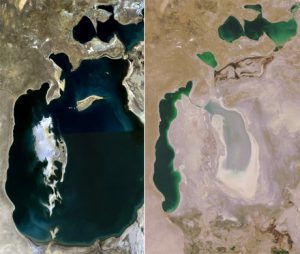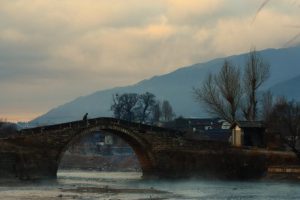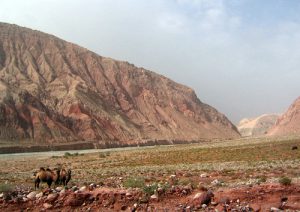Mining, dam construction, sand excavation, poaching and grassland degradation are seriously damaging the Qinghai-Tibet plateau, the world’s most fragile ecosystem. But without a second thought, the tourism industry has joined their ranks. The only difference is that tourism, rather than acting covertly, has swaggered in and brazenly harmed this beautiful and sacred place.
On June 15, local media announced that Tibet will launch boating tours on Yamdrok Lake, one of the largest sacred lakes in the Tibet Autonomous Region. This news sparked an immediate public outcry. Yamdrok Lake is less than 100 kilometres from Lhasa and, along with Namtso and Manasarovar, is one of Tibet’s three holy lakes. It is the largest inland lake in the northern Himalayas – a beautiful natural landscape of mountains and water, a rare sight in this world.
Actually, the lake has always been a popular destination, but this announcement aimed to raise its profile. Dawa, chairman of the Tibet Qomolangma Tourism Development Company, said the firm had bought a sightseeing boat called “the Qomolangma I”, two ferries and several small-sized speedboats from inland China, according to media reports. “We will put all our effort into attracting tourists to come and experience for themselves what it’s like to tour the lake,” he said.
But Yamdrok Lake is more than just a beautiful landscape, it has a special cultural significance for Tibetans. When important “Living Buddhas” pass away, such as the Dalai Lama and the Panchen Lama, senior monks visit Yamdrok Lake to chant mantras and pray. They watch for a sign in the lake, to show them in which child the reincarnated spirit has been reborn.
Most Tibetans could not even imagine motorised tourist boats shuttling about in a place like this, with tourists making a commotion on the peaceful lake. But now this sacred lake of theirs was to become the money-making playground for the local government and tourism companies.
At noon on the same day in June, two environmental activists, one Tibetan and one Han Chinese, held an emergency meeting at the Matchstick Man Café in Xining, the capital of Qinghai province. They decided to launch a campaign to “Save Yamdrok Lake” on Weibo (“Chinese Twitter”). Very early the next morning, Sun Mian, the founder of New Weekly magazine, posted a message on Weibo to his 270,000 followers, demanding that the Yamdrok Lake development should stop. Shortly afterward, the filmstar Chen Kun rallied his 17 million-plus followers: “Let’s leave something for the later generations! Don’t be blinded by short-term interests!”
Public attention on Yamdrok Lake grew dramatically, as celebrities like actress Yao Chen and singer Han Hong joined the campaign. Overnight, the lake grew from a local news story into a national issue. But because of the remote location of the lake, and because the local government and the tourism company refused all interviews, information about the situation could only be spread on Weibo.
A young Tibetan writer called Ying Sa posted an official news piece from five years ago on Weibo which said that the local government had given the tourism company permission to develop Yamdrok Lake: “Nagarze County, Lhoka, Tibet and the Tibet Qomolangma Tourism Development Company will collaborate to transform Yamdrok Lake into a top quality tourism site and work hard to create a good investment environment for Yamdrok Lake.”
Online, environmentalists questioned the actions of the local government; had this project passed an Environmental Impact Assessment? Some internet users urged people to file a complaint on the local government’s official website
The public outcry soon caught the attention of the local government. On June 18, @SaveYamrokLake received a private message from @Tibet Daily: “We are reporting in our morning paper that this project has already been suspended.”
Tourism has been destroying Tibet’s sacred mountains and holy lakes for a long time. Qinghai Lake is a top-grade national scenic spot in Qinghai province and China’s biggest saltwater lake. But it is being over-exploited.
Back in May 2004, a local tourism company announced it would launch a luxury cruise boat called the “Qinghai Pearl” on Qinghai Lake. The boat would have food, sleeping berths and entertainment for tourists. It would be a floating “four-star hotel”. But several academics spoke out against the project. Qinghai Lake is an inland lake; water can flow in, but it cannot flow out. And so all the waste oil, waste water and litter produced by the cruise ship would permanently pollute the lake. The polluted water would be impossible to clean up, causing irreversible damage to the lake’s ecosystem.
Academic Sun Honglie pointed out that there would be no way to deal with pollution using existing technology, unless pollution was “ladled out, spoonful by spoonful, and clean water poured in.”
Opposition from academics and questions raised by the media forced the Qinghai provincial government to suspend the cruise boat project on Qinghai Lake in the end. By then, about 70% of the so-called luxury cruiser had been built at a construction site on the shores of the lake.
Founder of the “Qinghai-Tibet Plateau Ecological Protection website” Tashi Nyima also joined the campaign to oppose the development of Yamdrok Lake. He said that the environment of Qinghai Lake was being damaged by a heavy load of tourists and boats. Of course, this is not only an environmental issue; it is also about respecting local culture. In an article by Tashi Nyima, he wrote that, even if the activities on Qinghai Lake are environmentally friendly, they do not respect local people’s religious beliefs concerning sacred lakes. Local beliefs in “holy mountains and sacred lakes” play an important role in conserving the Tibetan plateau’s natural resources; their “environmental ethnics” have provided a kind of invisible protection.
But time after time, foreign tourists and explorers fail to respect local culture and break religious taboos. In 2004, when a sports teacher from Beijing called Zhang Jian announced that he would swim across the holy Namtso Lake, it sparked great outrage. Namtso, which means “heavenly lake” in Tibetan, is the world’s highest saltwater lake and a sacred site for Tibetans. Many Buddhists meditate in the caves in the cliffs along the edge of the lake.
The year before, Zhang Jian swam across Qinghai Lake, upsetting local Tibetans there. In his quest to conquer Namtso Lake, he again aroused strong opposition. The very popular Tibetcul website published an open letter: “Don’t rush recklessly to every blade of grass and every tree, every hill and every stream. Over the course of history, local people and nature have created a special ecosystem. It should be treasured, and more importantly, it should be respected.
Zhang Jian cancelled his plans to swim across the lake.
The open letter said: “The reason why people call the Qinghai-Tibet plateau the “world’s last pure land” is not just because of its geographical features, but also because of its profound cultural significance. These “sacred sites” are scattered across the plateau: sacred lakes such as Namtso Lake and Qinghai Lake, holy mountains such as Mount Kailash and Khawakarpo Mountain; and revered buildings like the Potala Palace.”
Unfortunately, not a single one of these sacred sites has escaped desecration. Khawakarpo Mountain, which stands over 6,000 metres high, is the world’s highest unclimbed peak. In 1991, a team of Chinese and Japanese climbers attempted to scale the summit. The local people strongly opposed their mission. They prostrated and burnt incense for the mountain, entreating the mountain spirits to stop these outsiders from disrespecting the holy mountain. The climbers were caught in a sudden blizzard and 17 of them died.
In 1996, the Japanese climbing team tried again, but local people blocked their way on a bridge over the Lancang River. Again, the climbing expedition ended in failure. Later, the local government honoured the local people’s wishes and prohibited mountaineering in the Meili Snow Mountains, after gaining the central government’s approval.
But while mountain climbing is now prohibited, the tourist industry has developed in leaps and bounds. Last year, when I was at Khawakarpo Mountain, I saw that the excessive number of visitors had already damaged this holy mountain. The village road that heads deep into the mountains was covered in rubbish. Forests had been cut down to make way for places for tourists to stay. People butchered livestock at the foot of the sacred mountain to cater to travellers needs. This would have been unimaginable in the past.
On top of this, official tourism companies and local people now scramble for profit. Revenue from ticket sales is not shared with local people. One local person said: “The infrastructure has grown old, no one looks after it. No one is repairing the wooden roadways on the cliffs; no one is looking after the power; no one is looking after the water; no one is looking out for mudslides! These problems have been created by the government because they handed the Meili Snow Mountains over to companies to manage. Companies put their profits first. They take the money and leave all the bad things behind, such as rubbish.”
In my book called Heavenly Beads, I interviewed Zha Duo, the executive director of the Snowland Great Rivers Environmental Protection Association. He said: “The Qinghai-Tibet Plateau is like a famous painting. This painting is serene, peaceful, like the ideal Shangri-La. But people defile her at will: tourism, mining, blasting holy mountains, cutting down forests and damming rivers. The Qinghai-Tibet plateau is deteriorating at such a rate that it’s as if she doesn’t even have the strength to take a breath. People in the east make money so that they come to the west. But all they think about is money. Who will come and value this famous painting? Who has both the ability and the compassion to protect her?”
Luckily, more and more people are realising the true value of the Qinghai-Tibet plateau. And more and more people are willing to protect her, like those members of the public who expressed their opposition to the exploitation of Yamdrok Lake on Weibo.
The public are still sceptical about whether or not the local government has really put a stop to the boat project. chinadialogue gave Nagarze’s local government a phone call. An official who asked to remain anonymous said: “This project really has been suspended. The cruise ship has already been towed away under the direct supervision of the head of the county.” Some internet users say they have heard that that boat has been sent to Lhasa. But you can imagine how the company that owns the boat must be looking forward to the time when they can take it back to Yamdrok Lake or use it on another lake, jam packed with tourists.
Liu Jianqiang is chinadialogue’s Beijing-based deputy editor.
Homepage image by 李俊

